Trade-Offs among Sensing, Reporting, and Transmission in Cooperative CRNs
Abstract
:1. Introduction
- We formulate the secondary the throughput and collision probability in three cases of the cooperative CRNs, where each time slot in the CSS process consists of the sensing period, reporting period, and transmission period. In the time trade-off, the sensing time could be traded for additional mini-slots to obtain more local sensing results, and it could also be traded for longer transmission times. The impact of the fusion rule with a varying number of local sensing results is studied in the throughput and collision analysis.
- In three cases of the cooperative CRNs, according to the mathematical relationship between k and n, we, respectively, present a monotonicity analysis of the throughput and collision probability and provide an approach to the maximum the throughput in some cases of the sensing and fusion parameters under the collision constraint.
- The numerical results show that the throughput and the collision probability possess the monotonic property in some value intervals of the sensing and fusion parameters, which is of prime significance for the design of three periods in the slot structure of the CSS process. Moreover, the numerical results demonstrate that, with a given sensing period, the maximal throughput is achieved when the trade-off between the cooperative sensing accuracy, which results from the number of SUs participating in CSS, and transmission time is optimal. With a given reporting period, the maximal throughput is achieved when the trade-off between the local sensing accuracy and transmission time is optimal. With a given transmission period, the maximal throughput is achieved when the cooperative sensing accuracy, which is jointly determined by the local sensing accuracy and the number of SUs participating in CSS, is optimal.
2. Network Model and Notations
2.1. Network Model
2.2. Spectrum-Sensing Model
2.3. Reporting Model
3. Performance Analysis of the CRN with Given Sensing Period
3.1. Throughput Analysis
- When , the monotonicity of the throughput depends on and k. On the right-hand side of (15), the first term is negative, the summation of in the second term is positive, while the summation of in the second term is negative. Compared with the second item as follows, is more likely to decrease with the number of mini-slots n due to the larger value of k.
3.2. Collision Analysis
- When , the collision probability increases with the number of mini-slots n. Thus, the collision probability and the maximum permissible collision probability provide an upper bound of n for the throughput optimization.
3.3. Throughput Optimization
- When , the monotonicities of the throughput and the collision probability depend on the values of , , and k. Given specified values of the aforementioned parameters, the optimal n could be determined.
- When , the throughput increases with n, while the monotonicity of depends on the values of and k.
- When , the collision probability increases with the number of mini-slots n. Thus, the collision probability and the maximum permissible collision probability provide an upper bound of n. The monotonicity of the throughput is similar to the second item; thus, the provided upper bound of n achieves the maximum the throughput.
4. Performance Analysis of the CRN with a Given Reporting Period
4.1. Throughput Analysis
- When , the right-hand side of (27) depends on the values of and k. On the right-hand side of (27), the first term is negative, the second term with is negative, while the second term with is positive. Compared with the above first item, the throughput is more likely to decrease with due to the smaller value of k.
4.2. Collision Analysis
- When , the right-hand side of (34) is negative, and the collision probability decreases with . Thus, the maximum permissible collision probability provides a lower bound of for throughput optimization.
4.3. Throughput Optimization
- When , the collision probability decreases with ; thus, the maximum permissible collision probability provides a lower bound of in the interval . As turns from positive to negative with the increase of in , the optimal depends on the lower bound of and the value of that satisfies .
- When , the collision probability decreases with , and a lower bound of is also provided. The optimal depends on the values of and k.
- When , the monotonicities of the throughput and collision probability depend on the values of , , and k.
4.4. Special Case
5. Performance Analysis of the CRN with a Given Transmission Period
5.1. Throughput Analysis
5.2. Collision Analysis
5.3. Throughput Optimization
- When , the monotonicities of the throughput and the collision probability depend on , , and k.
- When , the throughput decreases with the number of mini-slots n when tends to 0. Comparing it with the third item, the collision probability is less likely to increase with the duration of the reporting period due to the larger value of k. The optimal n depends on , and k.
- When , the collision probability increases with the duration of the reporting period , and the maximum permissible collision probability provides an upper bound of n in the interval . As turns from negative to positive with the increase of , the optimal depends on the upper bound of n.
6. Numerical Results
7. Conclusions
Author Contributions
Funding
Institutional Review Board Statement
Informed Consent Statement
Data Availability Statement
Conflicts of Interest
References
- Sani, M.; Tsado, J.; Thomas, S.; Suleiman, H.; Shehu, I.; Shan’una, M. A Survey on Spectrum Sensing Techniques for Cognitive Radio Networks. In Proceedings of the International Conference on Multidisciplinary Engineering and Applied Science (ICMEAS), Abuja, Nigeria, 15–16 July 2021; pp. 1–5. [Google Scholar]
- Al, A.; Hamouda, W. Advances on spectrum sensing for cognitive radio networks: Theory and applications. IEEE Commun. Surveys Tuts. 2017, 19, 1277–1304. [Google Scholar] [CrossRef]
- Liang, Y.-C.; Zeng, Y.; Peh, E.; Hoang, A.T. Sensing-the throughput trade-off for cognitive radio networks. IEEE Trans. Wireless Commun. 2008, 7, 1326–1337. [Google Scholar] [CrossRef]
- Dikmese, S.; Ilyas, Z.; Sofotasios, P.C.; Renfors, M.; Valkama, M. Sparse frequency domain spectrum sensing and sharing based on cyclic prefix autocorrelation. IEEE J. Sel. Areas Commun. 2017, 35, 159–172. [Google Scholar] [CrossRef]
- El-Alfi, N.A.; Abdel-Atty, H.M.; Mohamed, M.A. Sub-Nyquist cyclostationary detection of GFDM for wideband spectrum sensing. IEEE Access 2019, 7, 86403–86411. [Google Scholar] [CrossRef]
- Sedighi, S.; Taherpour, A.; Gazor, S.; Khattab, T. Eigenvalue-based multiple antenna spectrum sensing: Higher order moments. IEEE Trans. Wireless Commun. 2017, 16, 1168–1184. [Google Scholar] [CrossRef]
- Tavana, M.; Rahmati, A.; Shah-Mansouri, V.; Maham, B. Cooperative sensing with joint energy and correlation detection in cognitive radio networks. IEEE Commun. Lett. 2017, 21, 132–135. [Google Scholar] [CrossRef]
- Zheng, K.; Liu, X.; Zhu, Y.; Chi, K.; Liu, K. Total the throughput maximization of cooperative cognitive radio networks with energy harvesting. IEEE Trans. Wireless Commun. 2020, 19, 533–546. [Google Scholar] [CrossRef]
- Liu, X.; Zheng, K.; Chi, K.; Zhu, Y. Cooperative spectrum sensing optimization in energy-harvesting cognitive radio networks. IEEE Trans. Wirel. Commun. 2020, 19, 7663–7676. [Google Scholar] [CrossRef]
- Yuan, X.; Shi, Y.; Qin, X.; Hou, Y.T.; Lou, W.; Sherali, H.D.; Kompella, S.; Midkiff, S.F.; Reed, J.H. Beyond overlay: Reaping mutual benefits for primary and secondary networks through node-level cooperation. IEEE Trans. Mobile Comput. 2017, 16, 2–15. [Google Scholar] [CrossRef]
- Liu, X.; Zheng, K.; Fu, L.; Liu, X.; Wang, X.; Dai, G. Energy efficiency of secure cognitive radio networks with cooperative spectrum sharing. IEEE Trans. Mobile Comput. 2019, 18, 305–318. [Google Scholar] [CrossRef]
- Liu, X.; Zheng, K.; Liu, X.-Y.; Wang, X.; Zhu, Y. Hierarchical cooperation improves delay in cognitive radio networks with heterogeneous mobile secondary nodes. IEEE Trans. Mobile Comput. 2019, 18, 2871–2884. [Google Scholar] [CrossRef]
- Xu, Y.; Liu, J.; Shen, Y.; Liu, J.; Jiang, X.; Taleb, T. Incentive jamming-based secure routing in decentralized Internet of Things. IEEE Internet Things J. 2021, 8, 3000–3013. [Google Scholar] [CrossRef]
- Xu, Y.; Liu, J.; Shen, Y.; Jiang, X.; Ji, Y.; Shiratori, N. QoS-aware secure routing design for wireless networks with selfish jammers. IEEE Trans. Wireless Commun. 2021, 20, 4902–4916. [Google Scholar] [CrossRef]
- Tong, J.; Jin, M.; Guo, Q.; Li, Y. Cooperative spectrum sensing: A blind and soft fusion detector. IEEE Trans. Wireless Commun. 2018, 17, 2726–2737. [Google Scholar] [CrossRef]
- Alhamad, R.; Wang, H.; Yao, Y.D. Cooperative spectrum sensing with random access reporting channels in cognitive radio networks. IEEE Trans. Veh. Technol. 2017, 66, 7249–7261. [Google Scholar] [CrossRef]
- Chaurasiya, R.B.; Shrestha, R. Area-efficient and scalable datafusion based cooperative spectrum sensor for cognitive radio. IEEE Trans. Circuits Syst. Express Briefs 2021, 68, 1198–1202. [Google Scholar] [CrossRef]
- Guimaraes, D.A. Pietra-ricci index detector for centralized data fusion cooperative spectrum sensing. IEEE Trans. Veh. Technol. 2020, 69, 12354–12358. [Google Scholar] [CrossRef]
- Liu, X.; Jia, M.; Zhou, M.; Wang, B.; Durrani, T. Integrated cooperative spectrum sensing and access control for cognitive industrial Internet of Things. IEEE Internet Things J. 2022. [Google Scholar] [CrossRef]
- Lee, D.-J. Adaptive random access for cooperative spectrum sensing in cognitive radio networks. IEEE Trans. Wireless Commun. 2015, 14, 831–840. [Google Scholar] [CrossRef]
- Wang, W.; Chen, L.; Shin, K.G.; Duan, L. Secure cooperative spectrum sensing and access against intelligent malicious behaviors. In Proceedings of the 33rd Annual IEEE International Conference on Computer Communications (INFOCOM’14), Tornoto, ON, Canada, 27 April–2 May 2014; pp. 1267–1275. [Google Scholar]
- Wang, W.; Chen, L.; Shin, K.G.; Duan, L. Thwarting intelligent malicious behaviors in cooperative spectrum sensing. IEEE Trans. Mobile Comput. 2015, 14, 2392–2405. [Google Scholar] [CrossRef]
- Gharib, A.; Ejaz, W.; Ibnkahla, M. Distributed learning-based multi-band multi-user cooperative sensing in cognitive radio networks. In Proceedings of the IEEE Global Communications Conference (GLOBECOM), Abu Dhabi, United Arab Emirates, 9–13 December 2018; pp. 1–6. [Google Scholar]
- Gharib, A.; Ejaz, W.; Ibnkahla, M. Enhanced multiband multiuser cooperative spectrum sensing for distributed CRNs. IEEE Trans. Cogn. Commun. Netw. 2020, 6, 256–270. [Google Scholar] [CrossRef]
- Liu, H.; Chen, J.; Ding, G.; Yan, K.; Cui, L. Optimal cooperative spectrum sensing strategy in cognitive radio networks exploiting RF-energy harvesting. In Proceedings of the International Conference on Wireless Communications Signal Processing (WCSP), Nanjing, China, 17–25 October 2015; pp. 1–5. [Google Scholar]
- Yin, S.; Qu, Z.; Li, S. Achievable the throughput optimization in energy harvesting cognitive radio systems. IEEE J. Sel. Areas Commun. 2015, 33, 407–422. [Google Scholar] [CrossRef]
- Ejaz, W.; Hattab, G.; Cherif, N.; Ibnkahla, M.; Abdelkefi, F.; Siala, M. Cooperative spectrum sensing with heterogeneous devices: Hard combining versus soft combining. IEEE Syst. J. 2018, 12, 981–992. [Google Scholar] [CrossRef]
- Golvaei, M.; Fakharzadeh, M. A fast soft decision algorithm for cooperative spectrum sensing. IEEE Trans. Circuits Syst. Express Briefs 2021, 68, 241–245. [Google Scholar] [CrossRef]
- Yuan, S.; Li, L.; Chigan, C. On MMD-based secure fusion strategy for robust cooperative spectrum sensing. IEEE Trans. Cogn. Commun. Netw. 2019, 5, 504–516. [Google Scholar] [CrossRef]
- Zhang, Y.; Wu, Q.; Shikh-Bahaei, M. On ensemble learning based secure fusion strategy for robust cooperative sensing in full-duplex cognitive radio networks. IEEE Trans. Commun. 2020, 68, 6086–6100. [Google Scholar] [CrossRef]
- Liu, X.; Zheng, K. Probability-based fusion rule in cooperative spectrum sensing with impact of geographic location. IET Commun. 2022, 16, 963–976. [Google Scholar] [CrossRef]
- Perez, J.; Via, J.; Vielva, L.; Ramirez, D. Online detection and SNR estimation in cooperative spectrum sensing. IEEE Trans. Wirel. Commun. 2022, 21, 2521–2533. [Google Scholar] [CrossRef]
- Wang, T.; Song, L.; Han, Z.; Saad, W. Distributed cooperative sensing in cognitive radio networks: An overlapping coalition formation approach. IEEE Trans. Commun. 2014, 62, 3144–3160. [Google Scholar] [CrossRef] [Green Version]
- Jiang, Z.; Yuan, W.; Leung, H.; You, X.; Zheng, Q. Coalition formation and spectrum sharing of cooperative spectrum sensing participants. IEEE Trans. Cybern. 2017, 47, 1133–1146. [Google Scholar] [CrossRef]
- Zheng, K.; Liu, X.-Y.; Liu, X.; Zhu, Y. Hybrid overlay-underlay cognitive radio networks with energy harvesting. IEEE Trans. Commun. 2019, 67, 4669–4682. [Google Scholar] [CrossRef]
- Na, W.; Yoon, J.; Cho, S.; Griffith, D.W.; Golmie, N. Centralized cooperative directional spectrum sensing for cognitive radio networks. IEEE Trans. Mobile Comput. 2018, 17, 1260–1274. [Google Scholar] [CrossRef]
- So, J.; Srikant, R. Improving channel utilization via cooperative spectrum sensing with opportunistic feedback in cognitive radio networks. IEEE Commun. Lett. 2015, 19, 1065–1068. [Google Scholar] [CrossRef]
- Jiang, C.; Chen, Y.; Liu, K.J.; Ren, Y. Renewal-theoretical dynamic spectrum access in cognitive radio network with unknown primary behavior. IEEE J. Sel. Areas Commun. 2013, 31, 406–416. [Google Scholar] [CrossRef]
- Akyildiz, I.F.; Lo, B.F.; Balakrishnan, R. Cooperative spectrum sensing in cognitive radio networks: A survey. Phys. Commun. J. 2011, 4, 40–62. [Google Scholar] [CrossRef]
- Zheng, K.; Liu, X.; Zhu, Y.; Chi, K.; Li, Y. Impact of battery charging on spectrum sensing of CRN with energy harvesting. IEEE Trans. Veh. Technol. 2020, 69, 7545–7557. [Google Scholar] [CrossRef]
- Ma, L.; Li, Y.; Demir, A. Matched filtering assisted energy detection for sensing weak primary user signals. In Proceedings of the IEEE International Conference on Acoustics, Speech and Signal Processing (ICASSP), Kyoto, Japan, 25–30 March 2012; pp. 3149–3152. [Google Scholar]
- Zhao, W.; Li, H.; Jin, M.; Liu, Y.; Yoo, S. Eigenvalues-based universal spectrum sensing algorithm in cognitive radio networks. IEEE Syst. J. 2021, 15, 3391–3402. [Google Scholar] [CrossRef]
- Li, Y.; Jayaweera, S.K. Dynamic spectrum tracking using energy and cyclostationarity-based multi-variate non-parametric quickest detection for cognitive radios. IEEE Trans. Wireless Commun. 2013, 12, 3522–3532. [Google Scholar] [CrossRef]
- Sun, X.; Dai, L. To sense or not to sense: A comparative study of CSMA with Aloha. IEEE Trans. Wireless Commun. 2019, 67, 7587–7603. [Google Scholar] [CrossRef]
- Polyanin, A.D.; Manzhrov, A.V. Handbook of Mathematics for Engineers and Scientists, 1st ed.; Chapman & Hall/CRC Press, LCC: New York, NY, USA, 2007. [Google Scholar]
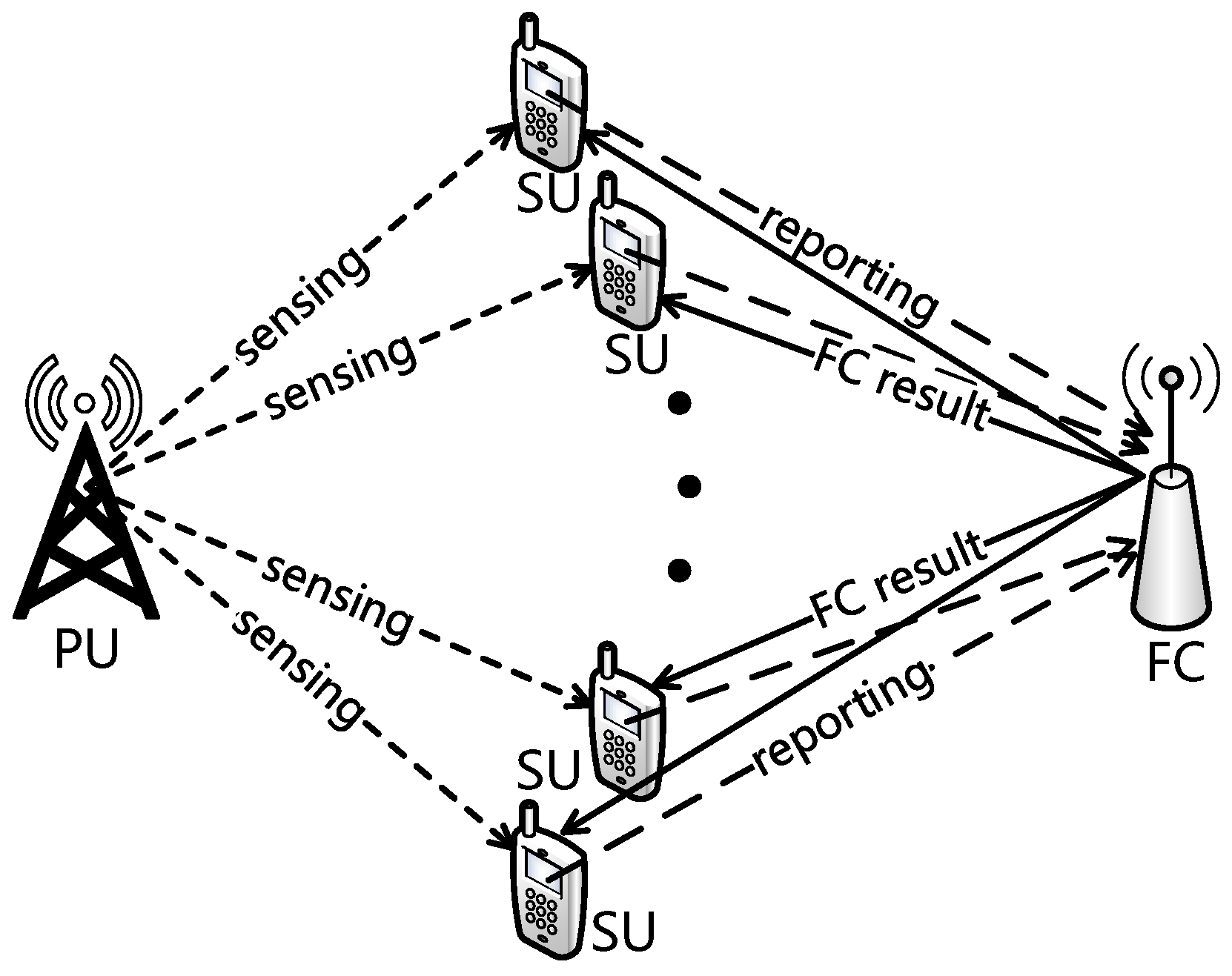
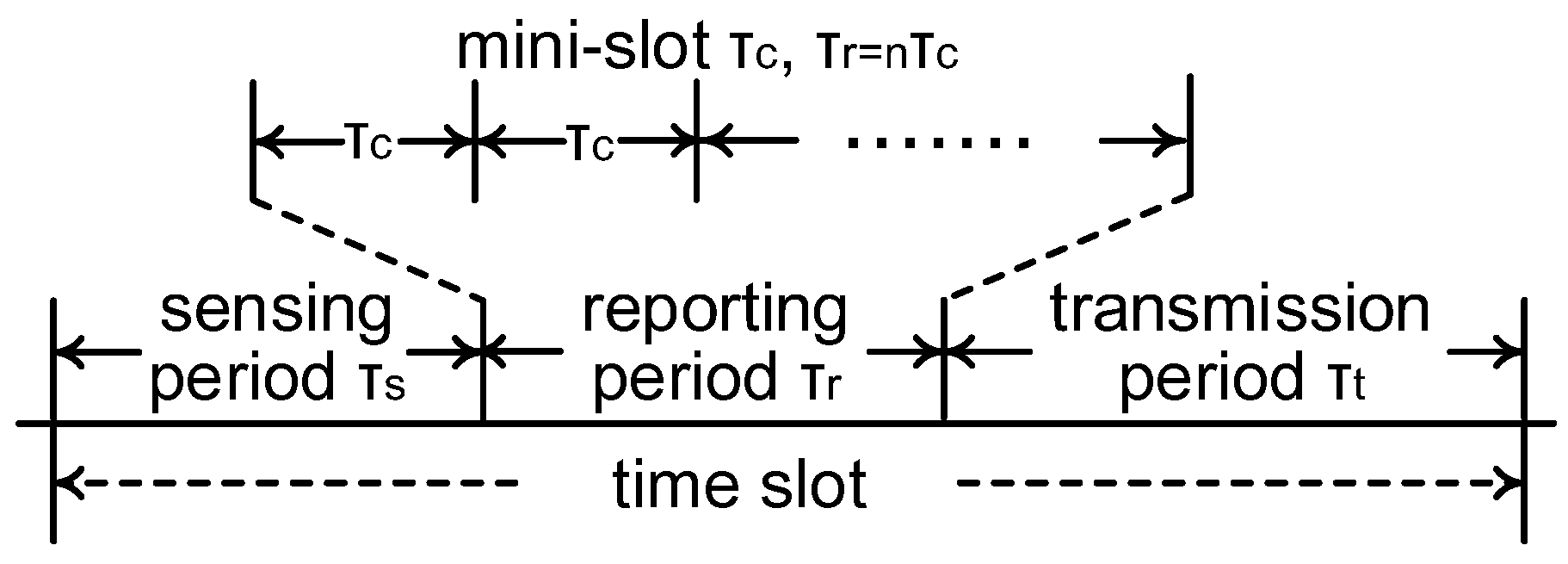

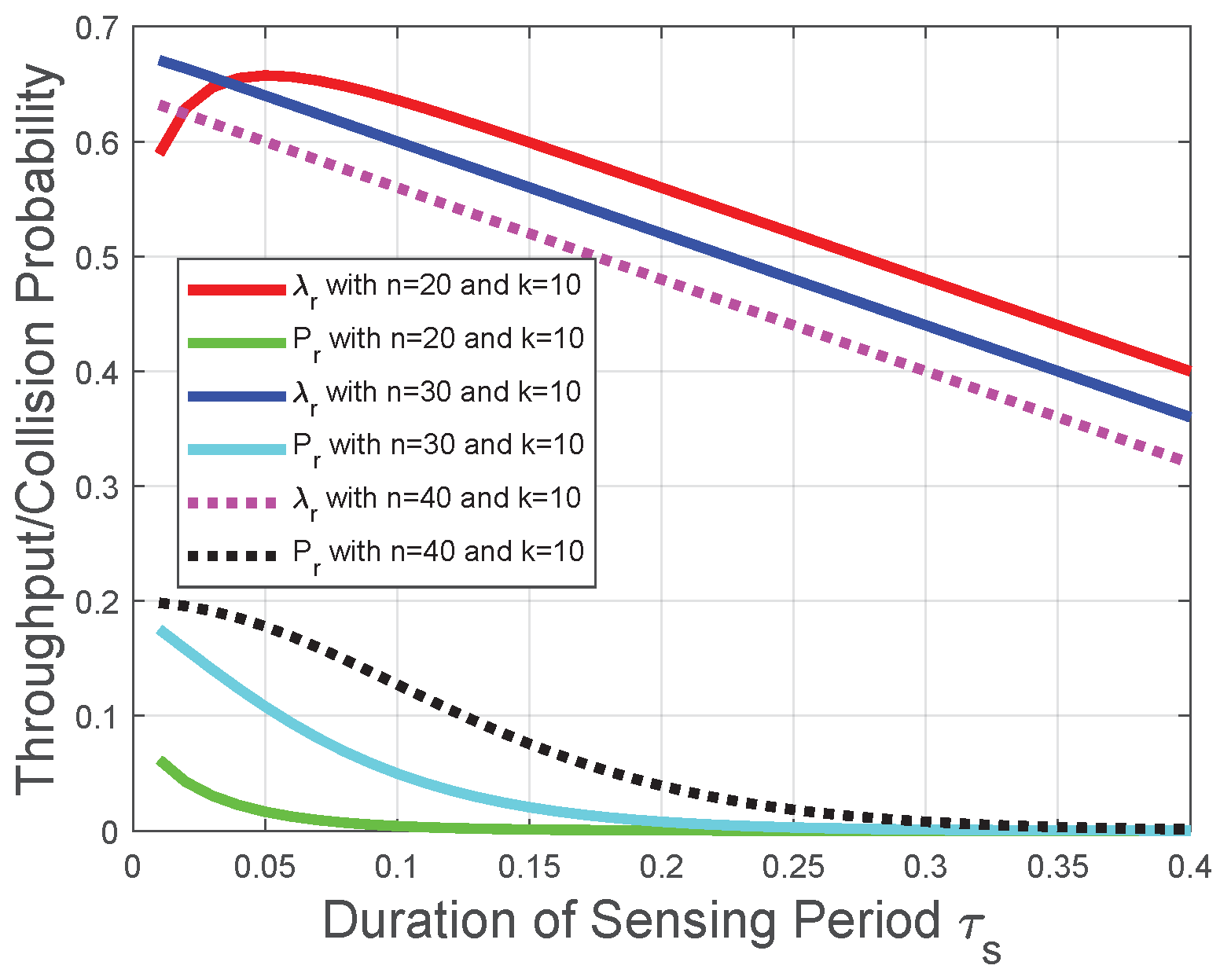
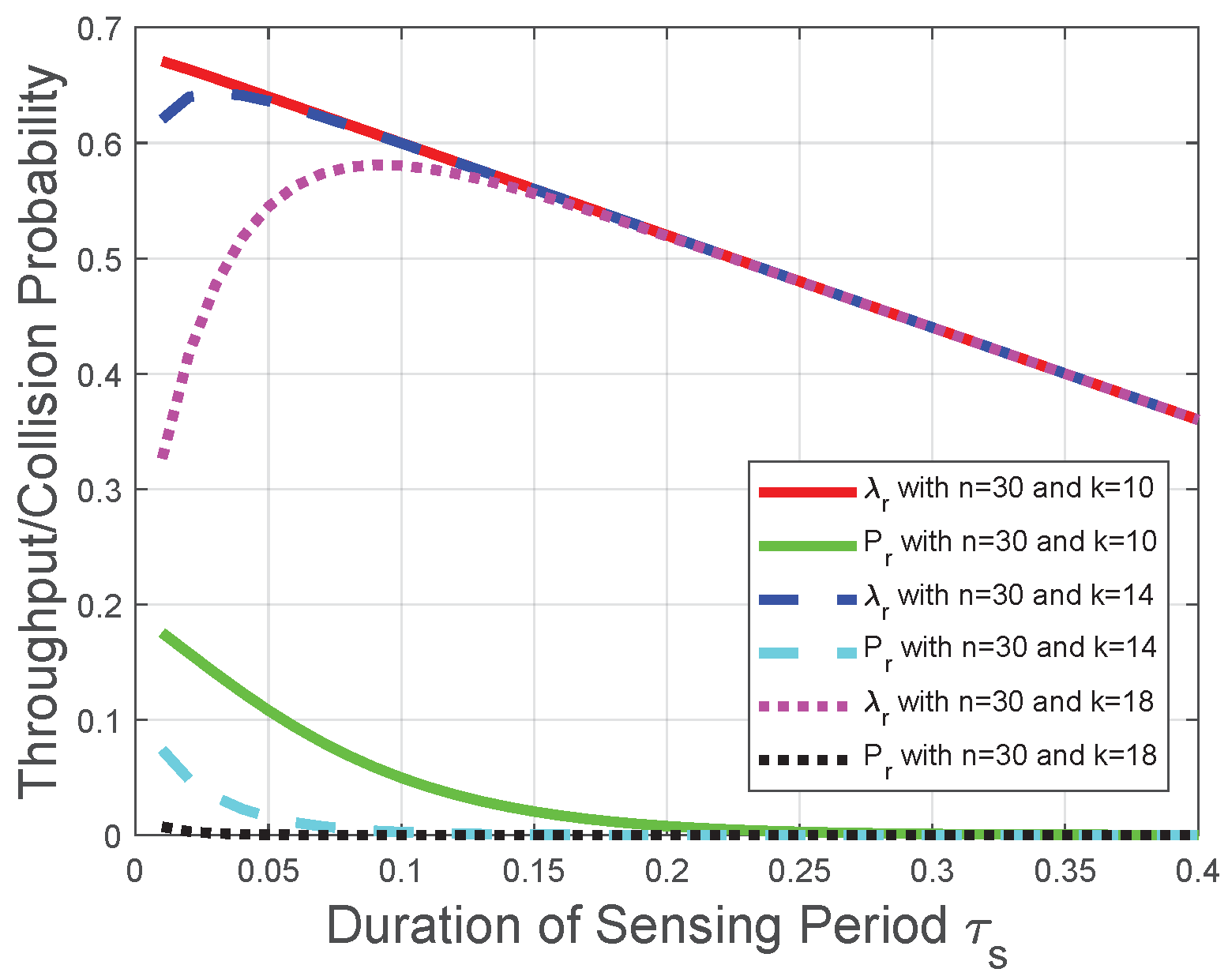
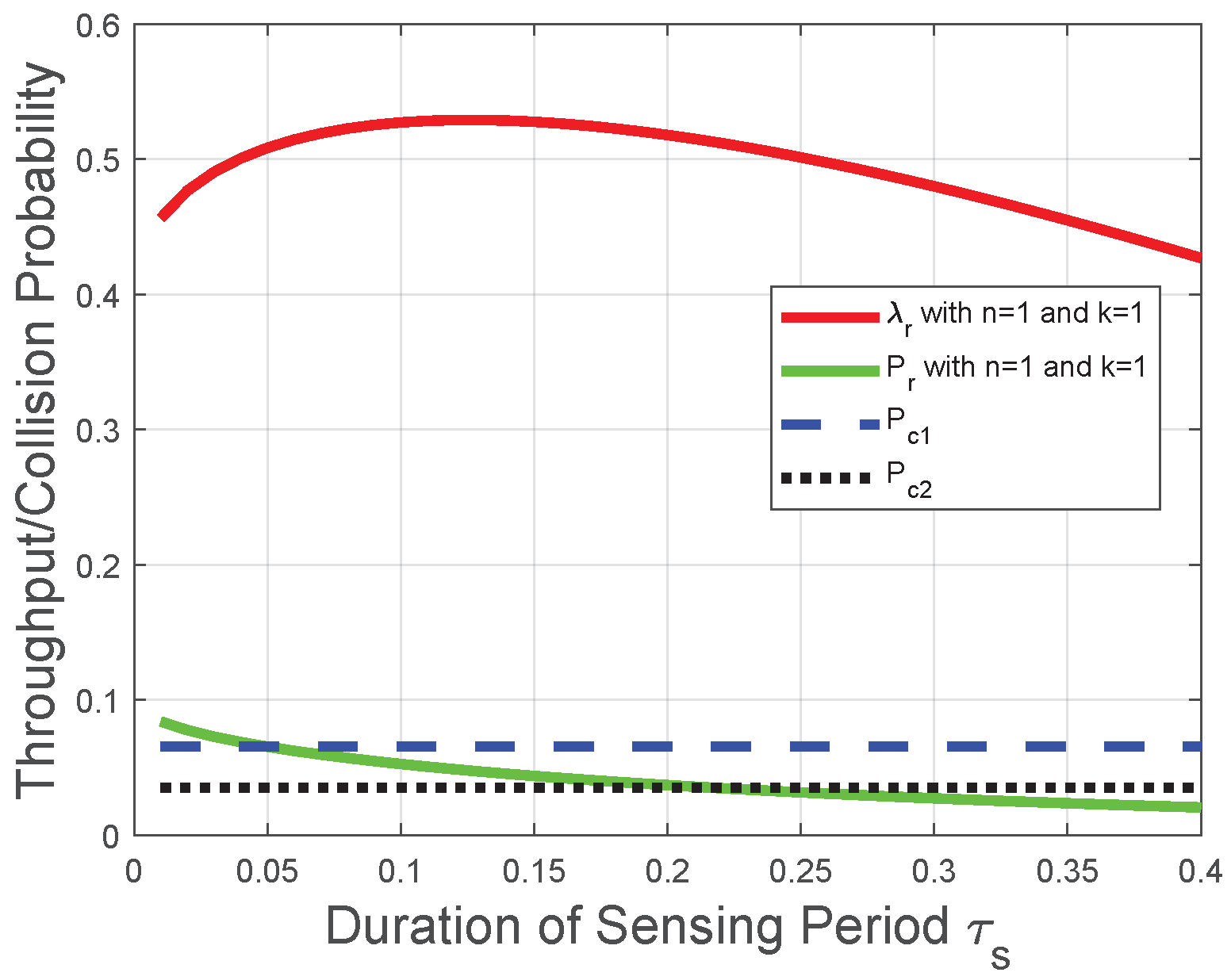
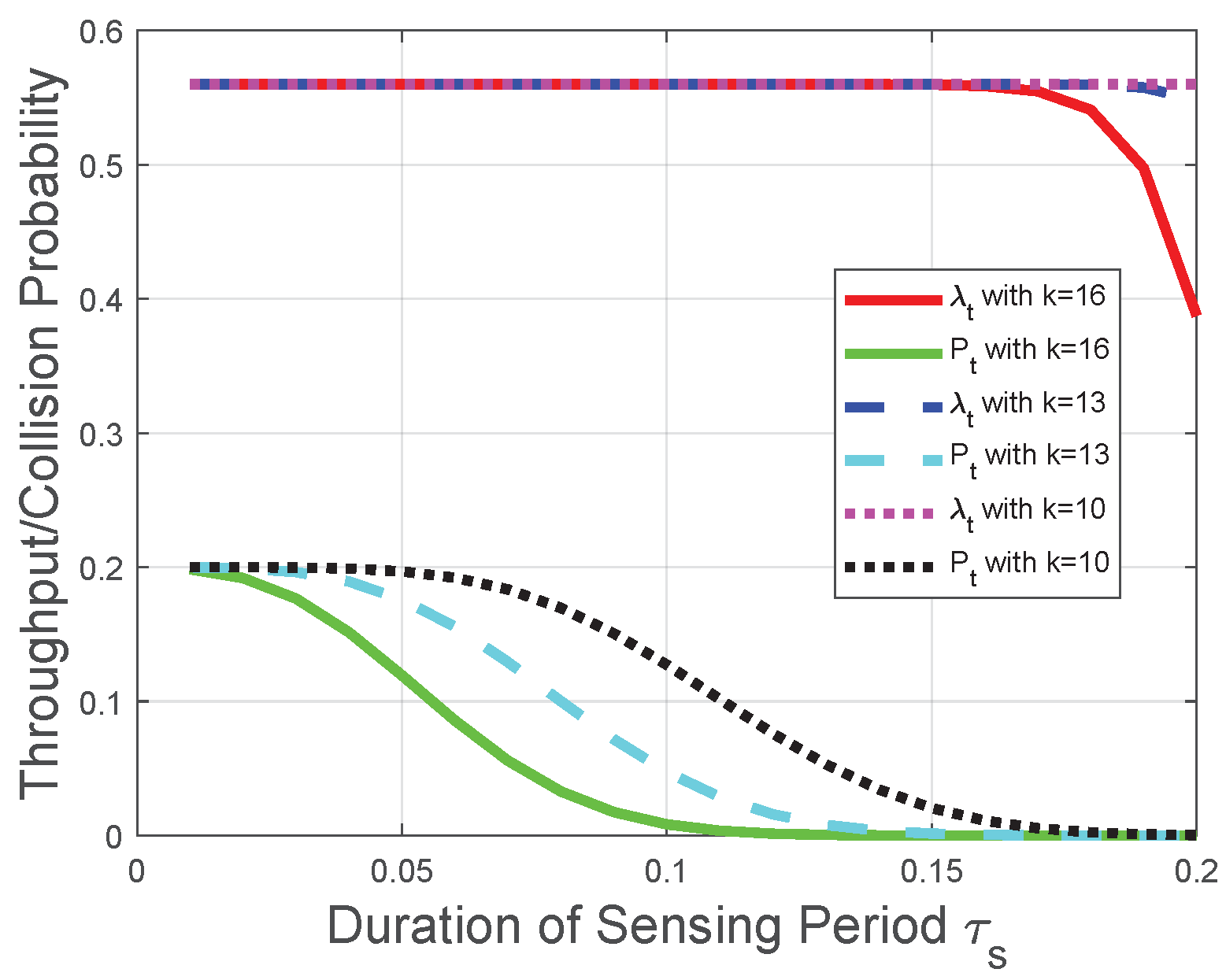
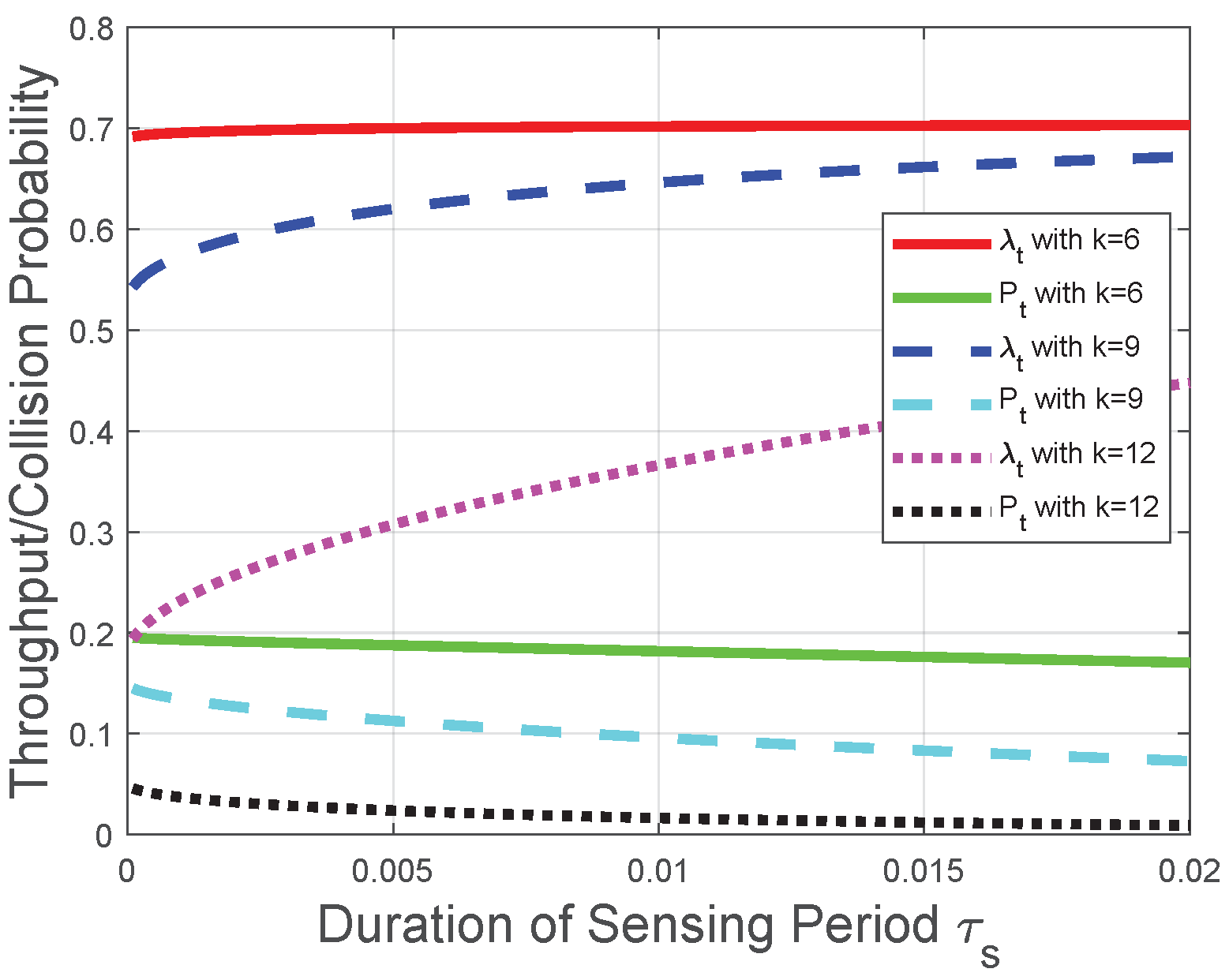
Publisher’s Note: MDPI stays neutral with regard to jurisdictional claims in published maps and institutional affiliations. |
© 2022 by the authors. Licensee MDPI, Basel, Switzerland. This article is an open access article distributed under the terms and conditions of the Creative Commons Attribution (CC BY) license (https://creativecommons.org/licenses/by/4.0/).
Share and Cite
Liu, X.; Zheng, K. Trade-Offs among Sensing, Reporting, and Transmission in Cooperative CRNs. Sensors 2022, 22, 4753. https://doi.org/10.3390/s22134753
Liu X, Zheng K. Trade-Offs among Sensing, Reporting, and Transmission in Cooperative CRNs. Sensors. 2022; 22(13):4753. https://doi.org/10.3390/s22134753
Chicago/Turabian StyleLiu, Xiaoying, and Kechen Zheng. 2022. "Trade-Offs among Sensing, Reporting, and Transmission in Cooperative CRNs" Sensors 22, no. 13: 4753. https://doi.org/10.3390/s22134753
APA StyleLiu, X., & Zheng, K. (2022). Trade-Offs among Sensing, Reporting, and Transmission in Cooperative CRNs. Sensors, 22(13), 4753. https://doi.org/10.3390/s22134753





